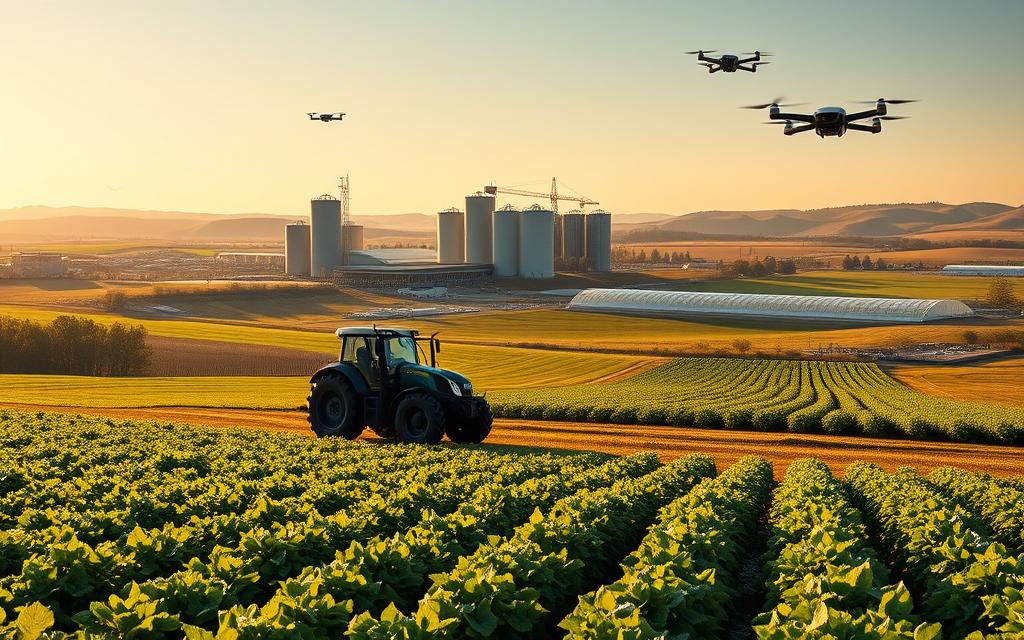The agricultural technology evolution has changed how we farm. Farmers now use satellite-guided tractors and soil sensors. These tools help them understand soil moisture levels in real time.
This change is more than just new gadgets. It has changed how we care for the land. It’s a big shift in how we interact with the earth.
New technology is used at every step of food production advancements. Robots pick fruits carefully, and CRISPR makes crops resistant to diseases. Internet-connected devices watch over animals, spotting health issues early.
These advances do more than just increase food. They help tackle climate change and use resources wisely. They’re making farming more efficient and sustainable.
Today, farming blends old ways with new tech. AI helps farmers grow food in a way that’s good for the planet. Vertical farms in cities show how tech can work in tight spaces.
This tech revolution affects everything. It changes global food systems and local markets. It’s a big change for farming and food.
From Hand Tools to Combines: A Historical Perspective
The journey of farming progress is a tale of human creativity. Over two centuries, simple tools evolved into complex machines that changed how we grow food. This change was not sudden but a series of steps that led to today’s farming methods.
The Agricultural Revolution (1700-1900)
In the 1700s, inventors started the first wave of farming mechanisation. Jethro Tull’s 1701 seed drill was a big step, cutting seed waste by 80%. By the 1830s, Cyrus McCormick’s reaper made harvesting grains faster, doing the work of five men.
Three key events sped up this change:
- Steam-powered tractors (1840s) replaced oxen teams
- Barbed wire fencing (1874) enabled controlled livestock grazing
- Hybrid corn varieties (1890s) boosted yields through selective breeding
Early mechanisation milestones
Iowa became America’s cattle capital thanks to Joseph Glidden’s barbed wire. As historical records show, this innovation helped farmers manage bigger herds. Henry Wallace’s work on hybrid corn in the 1890s showed how science could improve farming.
The big leap was the combine harvesters in the 1880s. These huge machines, pulled by 40 horses, could harvest, thresh, and clean grain at once. Though basic by today’s standards, they started the era of fully mechanised farming in the 20th century.
How Has Technology Changed Farming and Food Production?
Modern farming has seen huge changes in how much food we can grow. New tech has made farming more efficient and productive. Let’s look at how tech has changed farming and food production.
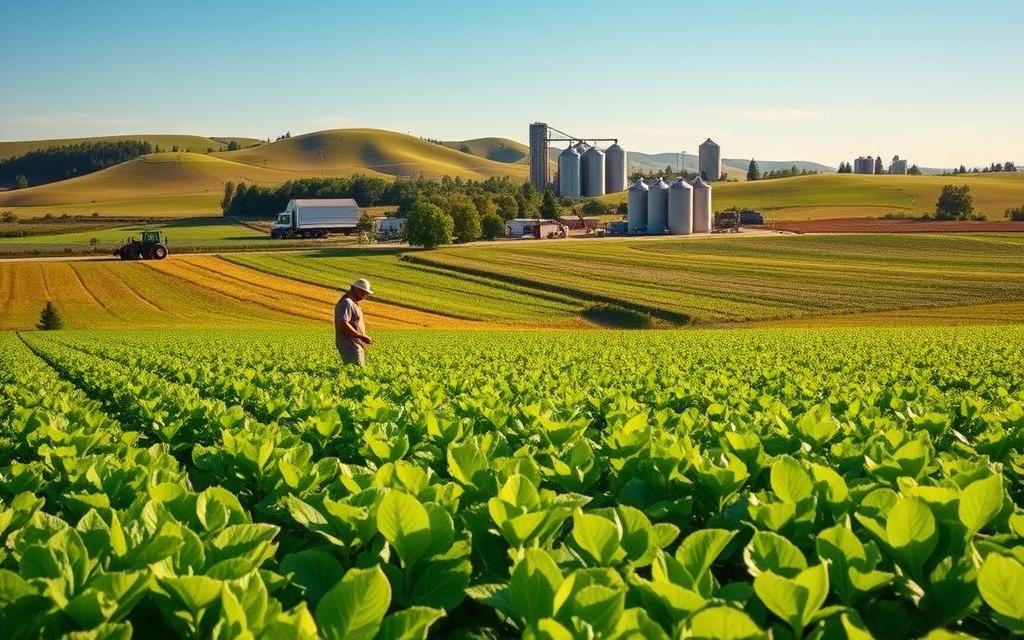
Mechanisation’s Labour Transformation
Old farming needed lots of people. Now, machines do the work in hours that took weeks before. The John Deere 8RX Tractor shows this big change.
- GPS-driven autonomous operation for 24/7 fieldwork
- Precision depth control for planting within 2.5cm accuracy
- Real-time soil analysis through integrated sensors
Case Study: John Deere 8RX Tractor Capabilities
McKinsey data shows these tractors need 65% less labour than old models. Farmers can now cover 40% more land daily and use 15% less fuel. An Iowa farmer said:
“The 8RX’s auto-steer lets me focus on crop strategy, not steering corrections.”
Yield Increases Through Innovation
New tech has made growing crops much more efficient. Look at corn production:
| Metric | 1950 | 2020 | Increase |
|---|---|---|---|
| Average Yield (bushels/acre) | 25 | 175 | 600% |
| Harvest Time (days/100 acres) | 14 | 2 | 85% reduction |
Comparative Data: 1950 vs 2020 Crop Outputs
USDA data shows today’s farms grow 7x more corn per acre than before. This is thanks to:
- Hybrid seed varieties with drought resistance
- Satellite-guided fertiliser application
- Automated pest detection systems
These new methods don’t just increase how much we grow. They also help us grow food in a way that’s good for the planet, even when the weather is tough.
Precision Agriculture Technologies
Modern farming uses precision farming equipment for better crop management. These tools help farmers check field conditions live, use resources wisely, and protect the environment. Let’s look at two big changes in farming.
GPS-Guided Systems
Satellite navigation has changed farming. The Trimble GFX-350 display shows how, with accuracy down to a few centimetres. It helps with planting and fertilising.
It also lets farmers:
- Use less chemical by avoiding overlaps (saving 5-15% in costs)
- Work at night with the same precision
- Work with Variable Rate Application systems
Trimble GFX-350 Display Implementation
Farmers say they miss fewer spots when seeding by 20%. The system works well with soil treatments. Trials showed a 12% increase in maize yield with better row spacing.
Drone Monitoring Solutions
Aerial crop monitoring is key for big farms. The DJI Agras T40 leads with its big payload and fast spraying. It’s used for:
- Targeted pesticide use
- Finding disease hotspots
- Mapping water stress
DJI Agras T40 Spraying Applications
This drone uses 30-50% less chemical than old methods. Its cameras spot leaks that humans can’t see. It covers 50 hectares per charge, saving 40% on orchard work.
These tools help save 35% water in smart irrigation. As they improve, they raise the bar for farming’s future.
Biotechnology’s Role in Crop Development
Modern farming faces big challenges like climate change and growing populations. Biotechnology is key, changing how we grow crops through agricultural genetic engineering and precision editing. This section looks at how science helps ensure food security and tackles tough ethical questions.
Genetic Modification Breakthroughs
Genetic modification has changed how we protect crops, starting in the 1990s. Scientists add traits to plant DNA, making them resistant to pests, diseases, and harsh weather.
Bt Corn Implementation in US Midwest
The use of Bacillus thuringiensis genes in maize is a big win. Now, 82% of US corn is Bt corn, making it safe for humans but toxic to pests. Farmers see:
- 40-60% less insecticide use
- 15% higher average yields
- Better crop quality
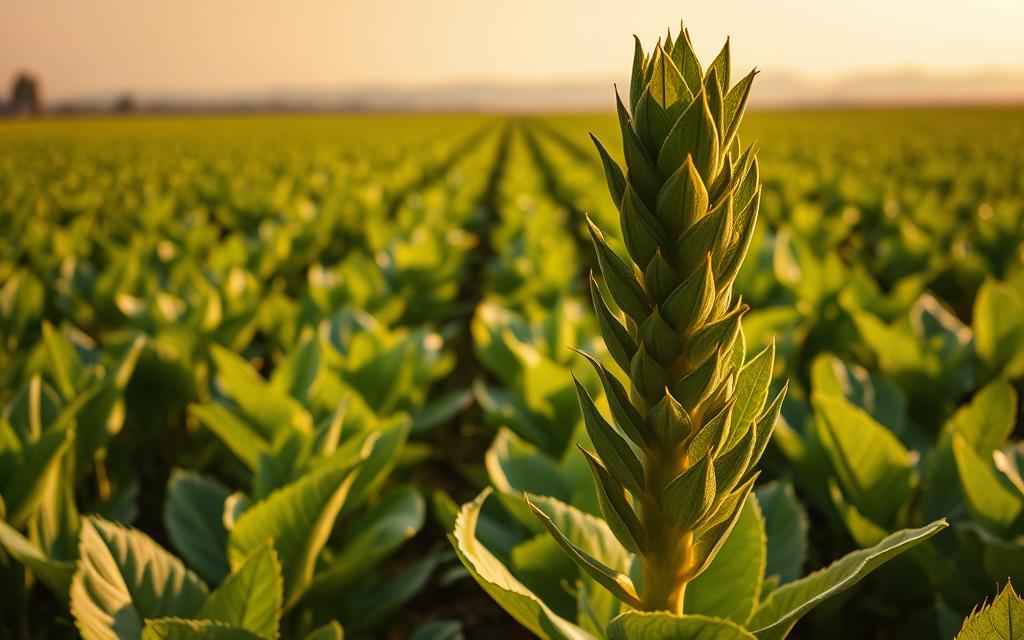
But, some people are worried. A 2023 USDA survey found 38% of Americans are unsure about genetically modified foods. This shows we need to talk more about it.
CRISPR Gene Editing Advances
CRISPR is different from traditional GMOs. It makes precise DNA changes without adding foreign genes. This speeds up the creation of crops that can handle tough weather, with less red tape.
Drought-Resistant Wheat Trials
CIMMYT’s new wheat is a big step forward for dry areas. Field tests showed:
| Metric | Standard Wheat | CRISPR-Edited Wheat |
|---|---|---|
| Water Requirements | 500mm/season | 400mm/season |
| Yield Stability | 63% | 83% |
| Protein Content | 12% | 14% |
CRISPR crop applications could get approved faster than GMOs. But, fights over who owns the rights to these new crops are a problem. The EU has strict rules, while the US is more open, causing confusion in the market.
“Gene editing could halve the time needed to develop stress-tolerant crops compared to conventional breeding.”
There are debates about who controls the seeds and the long-term effects on nature. Yet, 72% of agronomists think CRISPR is key to meeting UN Sustainable Development Goal 2 (Zero Hunger).
Smart Farming Through IoT Implementation
IoT has changed farming, making every field a source of real-time data and smart actions. It lets farmers watch over their crops closely and save resources. This change is clear in two key areas.
Soil Sensor Networks
Soil analysis has moved from manual tests to wireless sensors. These networks check moisture, nutrients, and temperature across fields. They send this data to farm management systems.
Climate FieldView System Analysis
The Climate Corporation’s FieldView shows IoT’s power. It mixes sensor data with satellite images. Users see 15% average water savings with its smart irrigation plans. An agronomist says:
“FieldView turns guesswork into math. We’ve seen soil health get better in just three growing cycles.”
Systems like ICL’s Agmatix also help. They compare sensor data with global soil databases. This lets farmers:
- Make special fertiliser mixes for each area
- Spot compaction problems early
- Balance pH levels over different terrains
Automated Irrigation Systems
IoT’s biggest water-saving tool is smart irrigation. It adjusts watering based on soil sensors and weather.
Netafim Techline CV Performance
Netafim’s drippers keep a steady flow, even on slopes. This is great for uneven fields. It has:
| Parameter | Traditional Systems | Techline CV |
|---|---|---|
| Water Distribution Uniformity | 75-82% | 94-97% |
| Energy Consumption | 1.8-2.2 bar | 1.0-1.5 bar |
| Terrain Adaptability | Limited to 5% slopes | Effective on 25% slopes |
California almond farmers see a 22% yield boost with these systems. They work best in dry areas. The system also cuts down on maintenance by avoiding sediment buildup.
Food Production and Supply Chain Innovations
Today, food systems use new technologies to improve safety and efficiency. These changes make it easier for food to get from farms to people. They also help fix old problems in the supply chain.
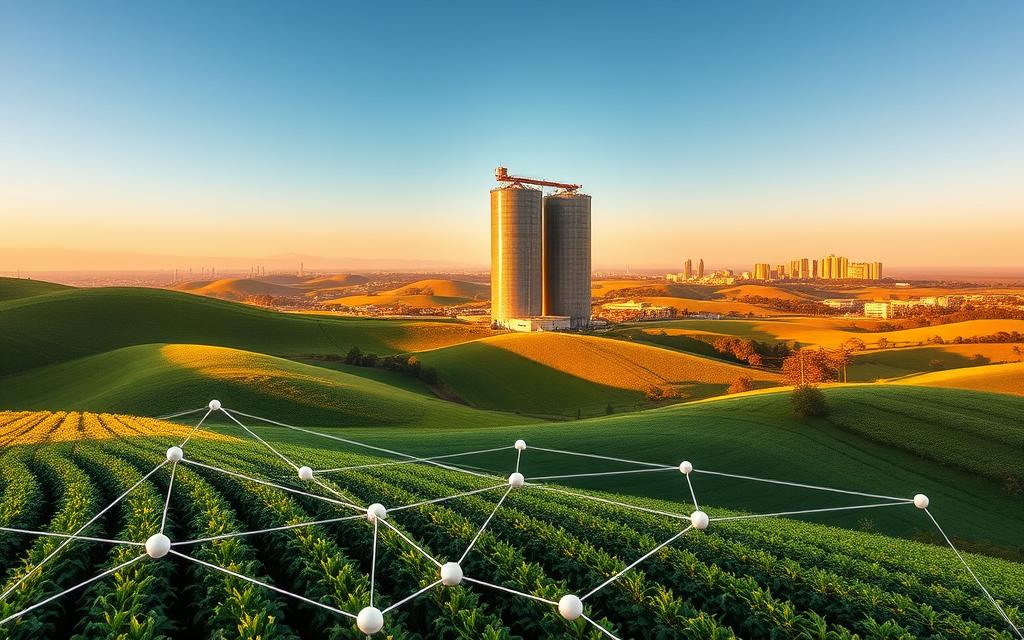
Blockchain Traceability Systems
Distributed ledger technologies bring new levels of transparency to food networks worldwide. Agricultural blockchain applications allow for quick tracking of ingredients. This helps fasten responses to contamination issues.
IBM Food Trust Case Study
IBM’s platform has made tracing pork in Chinese markets almost instant. It digitises data from farms to stores. This has cut recall costs by 30% and boosted trust among consumers.
| Metric | Traditional Tracking | Blockchain Solution |
|---|---|---|
| Traceability Time | 7-21 Days | 2.2 Seconds |
| Recall Costs | £10M Average | £7M (30% Reduction) |
| Data Accuracy | 65-75% | 99.9% |
Robotic Processing Equipment
Meat production is getting a boost from food robotics. ABB’s delta robots can do tasks like deboning poultry with great precision.
ABB FlexPicker in Poultry Plants
Tyson Foods says ABB’s FlexPicker can handle 200 birds a minute. This is three times faster than humans. It also cuts waste by 18% in US plants.
| Region | Automation Adoption Rate | Productivity Gain |
|---|---|---|
| North America | 34% | 41% |
| South America | 4.7% | 12% |
| Europe | 28% | 37% |
But, there are challenges in using these technologies in developing countries. Less than 5% of farms in South America use smart tools. This shows a big gap in global adoption.
Sustainability Through Agricultural Technology
Modern farming is facing a big challenge. It needs to be more productive and kinder to the environment. New technologies help farmers do both, making farming better for our planet.
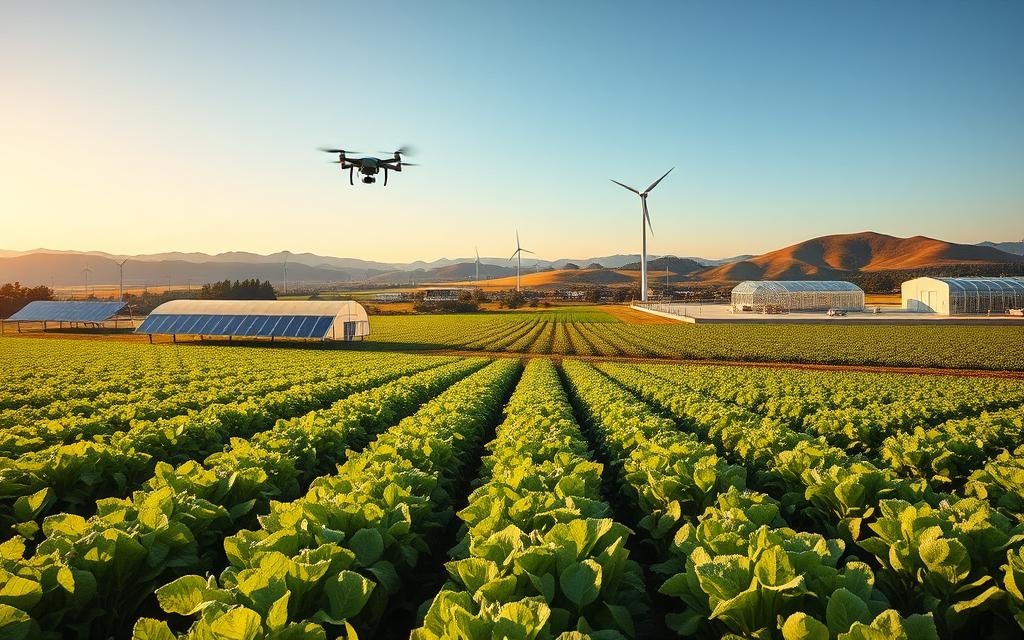
Renewable Energy Integration
Solar-powered irrigation systems are changing farming. They save money and reduce pollution. In Andalusia, solar pumps are used in citrus groves.
These pumps cover 20 hectares and use 90% less diesel. This means they stop about 12 tonnes of CO₂ from being released each year. That’s like taking six cars off the road.
Solar-powered irrigation pumps
Field tests with ICL’s biostimulants and solar irrigation show great results. Water retention in dry times goes up by 18%. Farmers say:
“The mix of renewable energy and soil enhancers helps us keep yields up, even when the weather is tough.”These systems can save money in just three harvests.
Precision Fertiliser Application
In Norway, barley fields are using precision nutrient management. Yara’s N-Sensor technology checks what the crops need and adjusts the fertiliser. This is done on uneven land.
Recent tests showed a 15% cut in nitrogen use without harming the grain quality. This is important for meeting EU rules on nitrate.
Yara N-Sensor field trials
Tractors with optical sensors make detailed maps of nutrient needs. This means:
- Applying fertiliser exactly where it’s needed
- Less chemical runoff
- Consistent protein levels in crops
This method helps meet global sustainability goals. It could reduce nitrous oxide emissions from farming by 20%. An agronomist says:
“We’re not just saving money – we’re also protecting our water and soil for the future.”.
Conclusion
Agricultural innovation is changing how we ensure food security and protect the environment. With the world’s population expected to hit 10 billion by 2050, farming must be both productive and eco-friendly. New technologies like AI and robotics help farmers make quick decisions and cut down on waste.
Vertical farming and swarm robotics are leading the way. Companies like ICL Group are exploring new greenhouses that use solar power and hydroponics. These systems could save up to 90% of water, helping to tackle water scarcity and emissions.
Biotechnology and smart sensors are making farming more resilient to climate change. Soil monitors and drought-resistant crops help farmers adapt to weather changes. This is detailed in an analysis of farming advancements.
New tech in renewable energy and blockchain is making supply chains more efficient and fair. These trends turn farming into a data-driven, sustainable ecosystem. To move forward, we need teamwork between tech experts, farmers, and policymakers to grow these solutions wisely.

